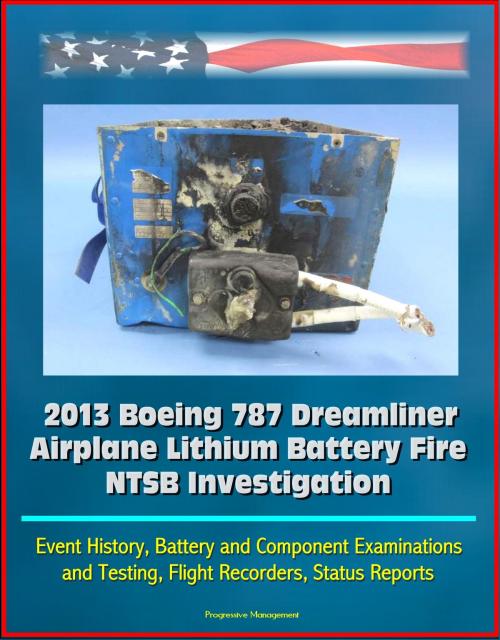2013 Boeing 787 Dreamliner Airplane Lithium Battery Fire NTSB Investigation: Event History, Battery and Component Examinations and Testing, Flight Recorders, Status Reports
Nonfiction, Science & Nature, Technology, Aeronautics & Astronautics| Author: | Progressive Management | ISBN: | 9781301823826 |
| Publisher: | Progressive Management | Publication: | March 7, 2013 |
| Imprint: | Smashwords Edition | Language: | English |
| Author: | Progressive Management |
| ISBN: | 9781301823826 |
| Publisher: | Progressive Management |
| Publication: | March 7, 2013 |
| Imprint: | Smashwords Edition |
| Language: | English |
This ebook provides an up-to-date compilation of documents and information from the National Transportation Safety Board (NTSB) about the ongoing investigation into fires and smoke incidents involving lithium-ion batteries on Boeing 787 Dreamliner commercial airplanes in 2013. It includes the March interim factual report which summarizes the NTSB's initial findings on the JAL battery fire investigation. The report includes details on how the maintenance personal discovered the fire and how the firefighters responded and extinguished it, findings from the examination of the battery and test results of related components, initial reports on the flight recorder data, a description of the 787 electrical power system certification plan, and a list of ongoing and planned investigative activities. Contents of that report include:
Abbreviations and Acronyms * Executive Summary * 1. Factual Information * 1.1 Event History * 1.2 Airplane Information * 1.3 Battery Information * 1.4 Flight Recorders * 1.5 Battery Examinations * 1.5.1 External Observations * 1.5.2 Battery Disassembly * 1.5.3 Battery Case Protrusion and Corresponding Cell Case Damage * 1.5.4 Radiographic Examinations * 1.6 Component Testing * 1.6.1 Battery Charger Unit * 1.6.2 Start Power Unit * 1.6.3 Battery Monitoring Unit * 1.6.4 Contactor * 1.6.5 Auxiliary Power Unit Controller * 1.7 System Safety and Certification * 1.7.1 Type Certification and Battery Special Conditions * 1.7.2 Certification Plan * 1.7.3 System Safety Assessment * 1.8 Federal Aviation Administration Actions After Battery Incidents * 1.9 Additional Information * 2. Ongoing and Planned Investigation Activities * Appendix—Boeing 787 Type Certification Special Conditions 25-359-SC.
On January 7, 2013, about 1021 eastern standard time, smoke was discovered by cleaning personnel in the aft cabin of a Japan Airlines (JAL) Boeing 787-8, JA829J, which was parked at a gate at General Edward Lawrence Logan International Airport (BOS), Boston, Massachusetts. About the same time, a maintenance manager in the cockpit observed that the auxiliary power unit (APU)—the sole source of airplane power at the time—had automatically shut down. Shortly afterward, a mechanic opened the aft electronic equipment (E/E) bay and found heavy smoke and fire coming from the front of the APU battery case.2 No passengers or crewmembers were aboard the airplane at the time, and none of the maintenance or cleaning personnel aboard the airplane was injured. Aircraft rescue and firefighting personnel responded, and one firefighter received minor injuries. The airplane had arrived from Narita International Airport, Narita, Japan, as a regularly scheduled passenger flight operated as JAL flight 008. The APU battery provides power to start an APU during ground and flight operations. Flight data recorder (FDR) data showed that the APU was started about 1004 while the airplane was being taxied to the gate after arrival at BOS. The FDR data also showed that, about 36 seconds before the APU shut down at 1021:37, the voltage of the APU battery began fluctuating, dropping from a full charge of 32 volts to 28 volts about 7 seconds before the shutdown. The APU battery consists of eight lithium-ion cells that are connected in series and assembled in two rows of four cells. Each battery cell has a nominal voltage of 3.7 volts. The cells have a lithium cobalt oxide compound chemistry and contain a flammable electrolyte liquid.
This ebook provides an up-to-date compilation of documents and information from the National Transportation Safety Board (NTSB) about the ongoing investigation into fires and smoke incidents involving lithium-ion batteries on Boeing 787 Dreamliner commercial airplanes in 2013. It includes the March interim factual report which summarizes the NTSB's initial findings on the JAL battery fire investigation. The report includes details on how the maintenance personal discovered the fire and how the firefighters responded and extinguished it, findings from the examination of the battery and test results of related components, initial reports on the flight recorder data, a description of the 787 electrical power system certification plan, and a list of ongoing and planned investigative activities. Contents of that report include:
Abbreviations and Acronyms * Executive Summary * 1. Factual Information * 1.1 Event History * 1.2 Airplane Information * 1.3 Battery Information * 1.4 Flight Recorders * 1.5 Battery Examinations * 1.5.1 External Observations * 1.5.2 Battery Disassembly * 1.5.3 Battery Case Protrusion and Corresponding Cell Case Damage * 1.5.4 Radiographic Examinations * 1.6 Component Testing * 1.6.1 Battery Charger Unit * 1.6.2 Start Power Unit * 1.6.3 Battery Monitoring Unit * 1.6.4 Contactor * 1.6.5 Auxiliary Power Unit Controller * 1.7 System Safety and Certification * 1.7.1 Type Certification and Battery Special Conditions * 1.7.2 Certification Plan * 1.7.3 System Safety Assessment * 1.8 Federal Aviation Administration Actions After Battery Incidents * 1.9 Additional Information * 2. Ongoing and Planned Investigation Activities * Appendix—Boeing 787 Type Certification Special Conditions 25-359-SC.
On January 7, 2013, about 1021 eastern standard time, smoke was discovered by cleaning personnel in the aft cabin of a Japan Airlines (JAL) Boeing 787-8, JA829J, which was parked at a gate at General Edward Lawrence Logan International Airport (BOS), Boston, Massachusetts. About the same time, a maintenance manager in the cockpit observed that the auxiliary power unit (APU)—the sole source of airplane power at the time—had automatically shut down. Shortly afterward, a mechanic opened the aft electronic equipment (E/E) bay and found heavy smoke and fire coming from the front of the APU battery case.2 No passengers or crewmembers were aboard the airplane at the time, and none of the maintenance or cleaning personnel aboard the airplane was injured. Aircraft rescue and firefighting personnel responded, and one firefighter received minor injuries. The airplane had arrived from Narita International Airport, Narita, Japan, as a regularly scheduled passenger flight operated as JAL flight 008. The APU battery provides power to start an APU during ground and flight operations. Flight data recorder (FDR) data showed that the APU was started about 1004 while the airplane was being taxied to the gate after arrival at BOS. The FDR data also showed that, about 36 seconds before the APU shut down at 1021:37, the voltage of the APU battery began fluctuating, dropping from a full charge of 32 volts to 28 volts about 7 seconds before the shutdown. The APU battery consists of eight lithium-ion cells that are connected in series and assembled in two rows of four cells. Each battery cell has a nominal voltage of 3.7 volts. The cells have a lithium cobalt oxide compound chemistry and contain a flammable electrolyte liquid.















